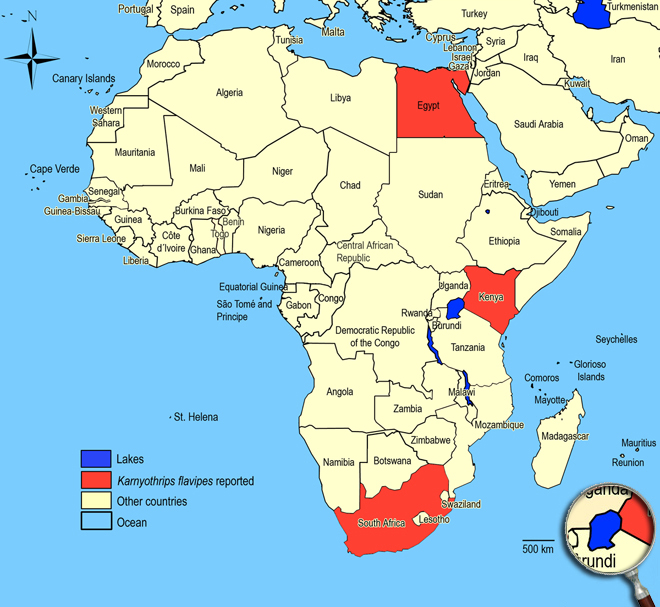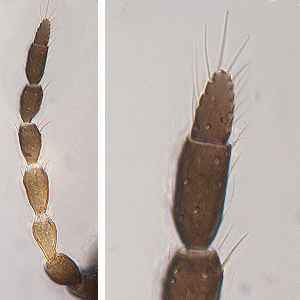Karnyothrips flavipes (Jones, 1912)
Phlaeothripinae, Phlaeothripidae, Tubulifera, Thysanoptera
Figures
Fig. 1: 8-segmented antenna, terminal segments VII and VIII
Fig. 2: Head dorsal with ocellar triangle
Fig. 3: Prothoracic sternal plates
Fig. 4: Meso- and metasternum
Fig. 5: Antenna and foreleg with tarsal tooth
Fig. 6: Fore wing
Fig. 7: Tergite IV with S-curved wing retaining setae
Fig. 8: Tergite X (= tube)
Introduction and recognition
Karnyothrips flavipes is a predator of various scale insects (Coccoidea) and commonly found on dead twigs or on leaves in association with other insects (Palmer & Mound 1991). Recently it has also been found to predate on coffee berry borer (Jaramillo et al. 2010). Female macropterous; body color brown; tarsi yellow; tibiae light brown particularly distally (Fig. 5); antennae brown, basal half of segment III mainly yellow (Fig. 1); fore wings and major setae pale; anal setae dark brown. Antennae 8-segmented; segment VIII broad at base; segment III with 2 small sense cones, IV with 2 or 3 (rare 4) sense cones, occasionally with an additional small sense cone. Head longer than wide (Fig. 2); eyes larger dorsally than ventrally; dorsal surface with little sculpture; postocular setae close to posterior margin of eyes, long and capitate; maxillary stylets one third of head width apart; maxillary bridge well developed. Pronotum with anteromarginal setae no larger than discal setae; 4 pairs of slender; capitate major setae, complete epimeral suture. Prosternal basantra slightly longer than wide; mesopraesternum transverse and slender (Fig. 3). Fore tarsus with forwardly directed tooth at inner apex (Fig. 5). Fore wing weakly constricted medially; with about 3 to 4 duplicated cilia (Fig. 6). Pelta reticulate and longer than wide; tergites II-VII each with 2 pairs of sigmoid wing-retaining setae (Fig. 7), these setae weak on II and VII; tergite IX setae S1 long and capitate, setae S2 longer than tube and finely acute; tube shorter than pronotum; anal setae 1.5 to 2.0 times as long as tube or longer (Fig. 8).
Up to now only 2 males have been studied.
Taxonomic identity
Species
Karnyothrips flavipes (Jones, 1912)
Taxonomic history
Watsoniella jonesiana Cott, 1950
Haplothrips oneco Watson, 1924
Haplothrips cubensis Watson, 1924
Hindsiana catchingsi Watson, 1924
Haplothrips harnedi Watson, 1922
Karynia weigeli Watson, 1922
Haplothrips funki Watson, 1920
Trichothrips ripicola Priesner, 1919
Zygothrips inermis Hood, 1919
Cryptothrips citri Watson, 1918
Zygothrips pullus Hood & Williams, 1915
Haplothrips longisetis Bagnall, 1913
Cryptothrips salicis Jones, 1912
Anthothrips flavipes Jones, 1912
Common name
-
Present taxonomic position
Family: Phlaeothripidae Uzel, 1895
Subfamily: Phlaeothripinae (Uzel) Priesner, 1928
Genus: Karnyothrips Watson, 1923
Genus description
The genus Karnyothrips Watson, 1923
More than 45 species are listed in this poorly defined genus Karnyothrips (Mound & Minaei 2007), of which about 30 are from North, Central and South America (Mound & Marullo 1996). A key to 14 species from Central and South America of the genus was given by Mound & Marullo (1996), and a key to 11 species from Japan was given by Okajima (2006). Stannard (1968) included 3 North American species within his treatment of the genus Haplothrips. Mound & Minaei (2007) discussed the problems in distinguishing between these two genera Haplothrips and Karnyothrips. Characteristic features of all members of the genus Karnyothrips are a maxillary bridge, a well developed prosternal basantra, slightly longer than wide, and fore tarsi with a considerably forward directed tooth at the inner apex, and anal setae much longer than tube (Mound & Marullo 1996).
Species description
Typical key character states of Karnyothrips flavipes
Coloration and body sculpture
Body color: mainly brown to dark brown
Antennae
Number of antennal segments: 8
Segment III - number of sense cones: 2
Segment IV - number of sense cones: 2-3 (4)
Form of sensorium on antennal segments III and IV: emergent and simple on segments III and IV
Head
Maxillary stylet position: about one third of head width apart
Postocular setae: about half to nine tenths as long as compound eye
Maxillary bridge: present
Cheeks: without seta-bearing tubercle
Prothorax
Number of pairs of elongate pronotal setae: 4
Prosternal basantra: present, longer than wide
Epimeral suture: complete
Wings
Fore- and hind wings: present and more than half as long as abdomen
Fore wings surface: smooth, without veins, setae and microtrichia
Fore wing veins: absent
Fringe cilia arising: not from sockets
Fore wing shape: mainly parallel sided or margins run continuously towards each other
Fore wing duplicated cilia: present
Fore wings: uniformly pale or weakly shaded
Fore wing extreme apex color: pale
Legs
Fore tarsus: with a forwardly directed and hook-like tooth near the apex
Abdomen
Tergites III to V: with 2 pairs of sigmoid curved wing-retaining setae
Abdominal segment 10: complete tube in both sexes

Similar or related species
Karnyothrips flavipes is very similar to Haplothrips species in structure, but has a prosternal basantra that is about as broad as long or longer than wide (Haplothrips with a basantra that is distinctly broader than long), anal setae 1.5 to 2.0 times as long as tube or longer (Haplothrips with anal setae mainly no more than 1.5 times as long as tube), anteromarginal pronotal setae not longer than discal setae (Haplothrips with anteromarginal setae usually longer than discal setae), and a fore tarsal tooth near the apex that is forwardly directed and hook-like (Haplothrips without or with a small lateral tooth).
Almost all species of Phlaeothripidae have a mainly brown body color, uniformly fore wings and tergites II-VII each with 2 pairs of wing-retaining setae (only Aleurodothrips fasciapennis with a bicolored body, fore wings with transverse alternating bands of dark and light, and tergites II-VII each with 1 pair of wing-retaining setae), and no seta-bearing tubercle on cheeks (only Hoplandrothrips marshalli has cheeks with at least 1 seta-bearing tubercle in basal third or 3 pairs laterally). Karnyothrips flavipes as well as species of Haplothrips and Gynaikothrips have a maxillary stylet position that is about one third of head width apart, and the length of postocular setae is about half to nine tenths as long as eye (in Aleurodothrips fasciapennis the maxillary stylet position is more than half of head width apart, and postocular setae are shorter than distance of the setal base from the eye; in Hoplandrothrips marshalli the maxillary stylet position is about one fifth of head width apart, and postocular setae are as long as dorsal length of eye or a little longer). Karnyothrips flavipes and species of Haplothrips with maxillar bridge and prosternal basantra (species of Gynaikothrips, Hoplandrothrips marshalli and Aleurodothrips fasciapennis have neither a maxillar bridge on head nor a prosternal basantra). Karnyothrips flavipes as well as Hoplandrothrips marshalli, Haplothrips (Haplothrips) gowdeyi, and species of Gynaikothrips have duplicated cilia on posterior margin of fore wing (Aleurodothrips fasciapennis and Haplothrips (Trybomiella) clarisetis without duplicated cilia on posterior margin of fore wing).
Biology
Life history
As with other thrips species the life cycle from egg to adult is dependent on temperature. The full cycle can take about 15 days (Lewis 1973) to over a month and adults may live for more than one month producing several generations in one year depending on seasonal weather.
Host plants
Collected frequently from many habitats, but primarily from dead branches and also on dead leaves and grasses; less commonly in flowers and on leaves.
Vector capacity
None identified.
Damage and symptoms
-
Detection and control strategies
-
Additional notes
Palmer & Mound (1991) record this species as predatory on several species of Diaspididae. Karnyothrips flavipes feeds mainly on scales, mites, whiteflies, and other thrips, and is frequently associated with bamboo and other Poaceae (Priesner 1964). However, it can also be found in the canopy of fruit trees preying on scales, mites, and herbivorous thrips (Childers & Nakahara 2006; Hoddle et al. 2002) and coffee berry borer (Jaramillo et al. 2010).
Biogeography
Widely throughout the tropics and subtropics, Egypt, Kenya (Kisii and Marsabit), South Africa.
African countries where Karnyothrips flavipes has been reported

The species Karnyothrips flavipes was not observed in surveys undertaken in East Africa on vegetables and associated weeds and crops.
Please click here for survey sites of all observed thrips species of Kenya, Tanzania and Uganda.

Bibliography
Bagnall RS (1913). Brief descriptions of new Thysanoptera - I. Annals and Magazine of Natural History, Zoology, Botany and Geology. (Serie 8) 12: 290-299
Childers CC & Nakahara S (2006). Thysanoptera (thrips) within citrus orchards in Florida: Species distribution, relative and seasonal abundance within trees, and species on vines and ground cover plants. Journal of Insect Science. 6 (45): 1-19
Hoddle MS, Nakahara S & Phillips PA (2002). Foreign exploration for Scirtothrips perseae Nakahara (Thysanoptera: Thripidae) and associated natural enemies on avocado (Persea americana Miller). Biological Control. 24 (3): 251-265
Jaramillo J, Chapman EG, Vega FE & Harwood JD ( 2010). Molecular diagnosis of a previously unreported predator-prey association in coffee: Karnyothrips flavipes predation on the coffee berry borer. Naturwissenschaften 97 (3): 291-298
Jones PR (1912). Some new California and Georgia Thysanoptera. Technical Series, USDA, Bureau of Entomology. 23 (1): 1-24
Lewis T (1973). Thrips: their biology, ecology and economic importance. Academic Press Inc., London Ltd., 349 pp.
Moritz G, Morris DC & Mound LA (2001). ThripsID - Pest thrips of the world. ACIAR and CSIRO Publishing Collingwood, Victoria, Australia, CDROM ISBN 1 86320 296 X
Mound LA & Kibby G (1998). Thysanoptera: An identification guide, (2nd edition). CAB International; Wallingford and New York, 70 pp
Mound LA & Marullo R (1996). The thrips of Central and South America: An introduction (Insecta: Thysanoptera). Memoirs on Entomology, International, Vol. 6. Associated Publishers, Gainsville, 487 pp
Mound LA & Minaei K (2007). Australian thrips of the Haplothrips lineage (Insecta:
Thysanoptera). Journal of Natural History, 41 (45-48): 2919-2978
Okajima S (2006). The Insects of Japan, Vol. 2. The suborder Tubulifera (Thysanoptera). Touka Shobo Co. Ltd., Fukuoka, 720 pp
Palmer JM & Mound LA (1991). Thysanoptera, pp. 67-76. In Rosen D [ed.], The armoured scale insects: their biology, natural enemies, and control, Vol. B. Elsevier, Amsterdam, 688 pp
Palmer JM, Mound LA & du Heaume GJ (1989). 2. Thysanoptera, 73 pp. In Betts CR [ed.], CIE Guides to insects of importance to man. CAB International, Wallingford, Oxon, UK
Pitkin BR (1973). A revision of the Australian Haplothripini, with descriptions of three new species (Thysanoptera: Phlaeothripidae). Journal of the Australian Entomological Society. 12: 315-339
Priesner H (1919). Zur Thysanopteren-Fauna Albaniens. Sitzungsberichte der Kaiserlichen Akademie der Wissenschaften. 128: 115-144
Priesner H (1964). A monograph of the Thysanoptera of the Egyptian deserts. Publications de l’Institut du Desert d’Egypte (1960). 13: 1-549
Stannard LJ (1968). The Thrips, or Thysanoptera, of Illinois. Illinois Natural History Survey Bulletin. 29 (4): 215-552
Watson JR (1918). Thysanoptera of Florida. Florida Buggist. 2: 65-77
Watson JR (1920). New Thysanoptera from Florida - VII. Florida Entomologist. 4 (2): 18-23
Watson JR (1922). Another camphor thrips. Florida Entomologist. 6 (1): 6-7
Watson JR (1922). A new thrips from citrus in Alabama. Florida Entomologist. 6 (3): 45
Watson JR (1923). Synopsis and catalog of the Thysanoptera of North America. Bulletin of the Agricultural Experiment Station, University of Florida. 168: 1-100
----
Web links
Mound´s Thysanoptera pages
Thysanoptera Checklist
ICIPE Thrips survey sites
UNI Halle & Thrips sites
Thrips of California











